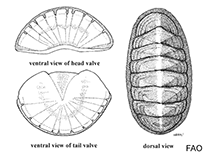Stenoplax petaloides (Gould, 1846)
Upload your photos
Google image | No image available for this species;
drawing shows typical species in Ischnochitonidae.
Google image | No image available for this species;
drawing shows typical species in Ischnochitonidae.
Classification / Names Common names | Synonyms | CoL | ITIS | WoRMS
Polyplacophora | Chitonida | Ischnochitonidae
Environment: milieu / climate zone / depth range / distribution range Ecology
Benthic. Tropical; 25°N - 18°N, 170°W - 154°W
Distribution Countries | FAO areas | Ecosystems | Occurrences | Introductions
Eastern Central Pacific: Hawaiian Islands.
Length at first maturity / Size / Weight / Age
Maturity: Lm ? range ? - ? cm Max length : 0.8 cm TL male/unsexed; (Ref. 283)
Short description Morphology
Body elongate, oval in shape; moderately elevated. Valve whitish to very light beige with a pattern of dark streaks, splotches of orange-red and scattered, round, bright, ultramarine spots; sometimes completely white or bluish-black, bluish-black with a white stripe along the dorsal or have a zebra stripe pattern of alternating pinkish and reddish-brown bands. Girdle moderate wide; whitish in color, irregularly blotched with light to dark green, covered with small, overlapping scales.
Life cycle and mating behavior Maturity | Reproduction | Spawning | Eggs | Fecundity | Larvae
Members of the class Polyplacophora are mostly gonochoric. Life cycle: Eggs hatch into lecitotrophic planktonic trocophore larvae (no veliger stage) which later metamorphose and settle on the bottom as young adults.
Main reference
References | Coordinator | Collaborators
Burghardt, G. and L. Burghardt. 2006. (Ref. 283)
IUCN Red List Status (Ref. 130435)
CITES status (Ref. 108899)
Not Evaluated
CMS (Ref. 116361)
Not Evaluated
Threat to humans
Harmless
Human uses
| FishSource |
Tools
More information
Internet sources
BHL | BOLD Systems | CISTI | DiscoverLife | FAO(Publication : search) | Fishipedia | GenBank (genome, nucleotide) | GloBI | Gomexsi | Google Books | Google Scholar | Google | PubMed | Tree of Life | Wikipedia (Go, Search) | Zoological Record
Estimates based on models
Price category
(Ref. 80766):
Unknown.



